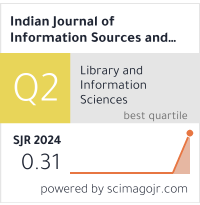Maker Space: A Beginner Way to Imparting Library for Adani Institute of Infrastructure Engineering
DOI:
https://doi.org/10.51983/ijiss.2020.10.2.488Keywords:
Maker space, 3D-Printing, Engineering libraries, librarians, library marketing, library Users, Adani Institute of Infrastructure Engineering, Infrastructure, Engineering, InnovationAbstract
Adani Institute of Infrastructure Engineering (AIIE) is established to equip the students to become modern-day engineers and managers primarily for the infrastructure and allied sectors. The Institute is presently conducting three Bachelor Programmes in Engineering. 1. BE- Civil & Infrastructure Engineering, 2.BE-Electrical Engineering, 3.BE -Information & Communication Technology. Adani Institute of Infrastructure Library embarked on a change journey in 2008 for services in support of the education. The concept for creating a maker space for engineering students within the library to foster activity -based learning. Maker spaces are over just places to create things; a maker space may be a physical location wherever people gather to share resources and knowledge, work on projects, network, and build. The NMC Horizon Report: 2015 higher education the paper examines the awareness and importance of library maker spaces. A questionnaire was used for collection of data. Around 50 questionnaires were distributed among the students. A total of 30 stuffed in questionnaires were selected for analysis of the data. While there is a push to include maker spaces in universities, very little is understood regarding the expertise of establishing maker spaces on engineering campuses. Typically, these maker spaces contain 3D printers and laser cutters, and offer facilities to conduct work, personal and collaborative projects. The idea for creating a maker space for engineering library is promotional activity-based learning. Maker spaces are over just places to make things; a maker space may be a physical location wherever people gather to share resources and knowledge, work practical projects, network, and build. Libraries that have lengthy been substitutable with peace and tranquillity are currently thought of as a part in which there have to be a stability between quiet surroundings and social dynamic mood. The intention of this study is to observe the importance of maker space of engineering libraries that is tremendously needed in technological advancements and alteration of ancient systems with new ones. This analysis consists of reviewing the domestic samples, conforming examples to library maker space and inspecting numerous libraries over a duration of time. The outcomes of this find out about indicate that generally, modern libraries have fewer areas for paper books and publications and individual study, instead, bigger spaces are committed to locations for cluster studies and the use of computer and maker space etc. This trade has influenced the function of the library space and maker space.
References
Adani Institute of Infrastructure Engineering (AIIE). (n.d.). Retrieved from http://www.aii.ac.in/aiie/
Gonzalez, S. R., & Bennette, D. B. (2014). Planning and implementing a 3D printing service in an engineering library. Issues in Science and Technology Librarianship. Retrieved from http://www.istl.org/14-fall/refereed3.html
Hussain, Akhtar, & Nisha, Faizul. (2017). Awareness and use of library maker spaces among library professionals in India: A study. DESIDOC Journal of Library & Information Technology, 37, 84-90. https://doi.org/10.14429/djlit.37.2.10989
Harbo, K., & Hansen, T. V. (2012). Getting to know library users' needs – experimental ways to user-centred library innovation. LIBER Quarterly, 21(3/4), 367–385. http://liber.library.uu.nl/index.php/lq/article/view/URN%3ANBN%3ANL%3AUI%3A10-1-113635
Harris, J., & Cooper, C. (2015). Make room for a maker space. Computers in Libraries, 35(2). Retrieved from https://www.questia.com/magazine/1P3-3682862781/make-room-for-a-makerspace
Massis, B. E. (2014). What’s new in libraries. New Library World, 115(5/6), 285-288. http://dx.doi.org/10.1108/NLW-03-2014-0030
Matthews, G., & Walton, G. (2014). Strategic development of university library space: Widening the influence. New Library World, 115(5/6), 237-249.
Moorefield-Lang, H. M. (2015). User agreements and maker spaces: A content analysis. New Library World, 116(7/8). Retrieved from http://www.emeraldinsight.com/doi/10.1108/NLW-12-2014-0144
Niskis, S. C. (2016). Access and express: Professional perspectives on public library maker spaces and intellectual freedom. Public Library Quarterly, 35(2), 103-125.
Okpala, H. N. (2016). Making a maker space case for engineering libraries in Nigeria. New Library World, 117(9/10).
Phetteplace, E., Dixon, N., & Ward, M. (2014). The maker movement and the Louisville free public library. Reference & User Services Quarterly, 54(1), 17-29.
Rich, S. N. (2014). A survey of maker spaces in engineering libraries. A master’s paper for the M.S. in Library Science degree. Advisor: Ronald E. Bergquist, April 26.
Wong, A., & Partridge, H. (2016). Making as learning: Maker spaces in universities. Australian Academic Research Libraries, 47(3), 143-159.
Downloads
Published
How to Cite
Issue
Section
License
Copyright (c) 2020 The Research Publication

This work is licensed under a Creative Commons Attribution-NonCommercial-NoDerivatives 4.0 International License.









